Symbiosis in Nature and Community
- Sustainable Development

In partnership with the J. Craig Venter Institute, this Designmatters studio challenged ArtCenter students to explore, conceptualize and translate scientific research on symbiosis into compelling visuals that communicate scientific discoveries to a broad range of audiences. This material is based upon work supported by the National Science Foundation under Grant No. IOS 1926972.
Through multiple class visits from scientists, transdisciplinary students were exposed to the intricate details of symbiosis in nature and how that partnership creates unique relationships among all life forms, from microscopic bacteria to the largest animal in the world, the whale. Students conducted additional research, ideated and designed visual representations of symbiosis to a specific target audience, merging art and science for an engaging and scientifically sound illustrative project.
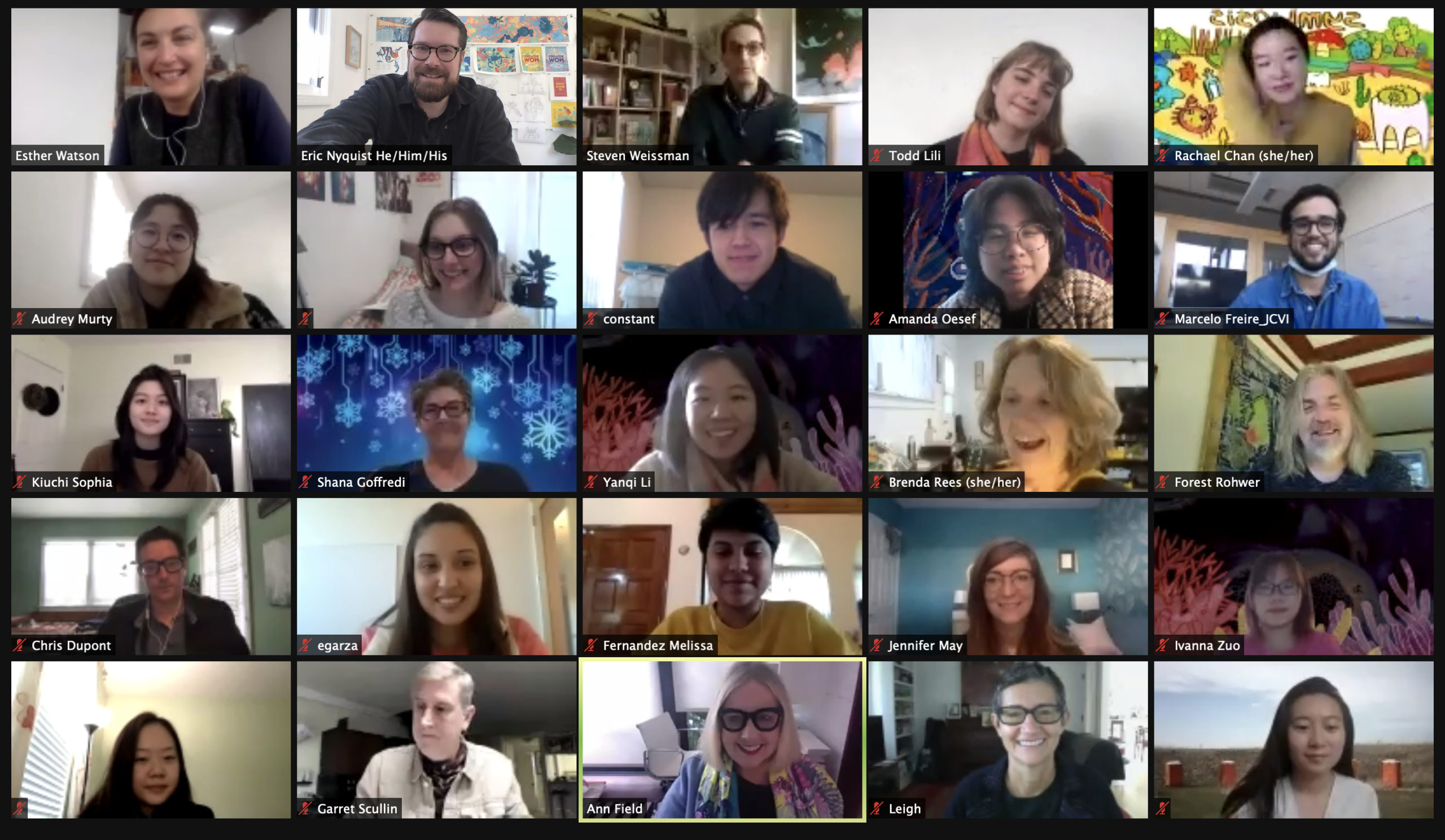
“It’s incredible to see a group of students who can learn about science and then think about the artistic ways to tell that story. You are inviting science to be a part of your life — whether you are walking and see a mural, or sitting into a science café or enjoying a book or magazine or teaching your child. The students taught us a lot.”
– Dr. Marcelo Friere, associate professor of Genomic Medicine and Infectious Disease at JCVI
Project Brief
Combining art and science for a graphically engaging final project, this Designmatters studio invited ArtCenter students to explore, translate and conceptualize a project based on the current scientific research on symbiosis. Students heard firsthand from scientists about the intricate details of symbiotic partnerships that exist in animal and plant life. Students then transformed that knowledge into a compelling illustrative project, communicating the scientific concepts to an appropriate target audience.
About Symbiosis
Symbiosis is the interaction between two or more organisms which provides benefits for both or all parties involved. Symbiotic interactions are ubiquitous throughout nature and provide natural design principles for engineering.
Many relationships involve microbes partnering with animals or plants in visually arresting and molecularly complex fashions. For example, mosses in boreal forests acquire one of their essential nutrients from a microbial partner. Yeti crabs harbor colonies of bacteria that provide sustenance at the bottom of the ocean. The concept of symbiosis extends to societal organizations, as well; physical distancing and mask wearing during a viral pandemic is a clear example of symbiosis.

“I knew this was going to be an transdisciplinary and collaborative project. To be able to work alongside and bounce ideas off of other artists and designers — as well as the scientists — was wonderful. I’ve always been fascinated with science, and I was so inspired that we got to combine art with science.”
– Melissa Fernandez, ArtCenter student
Research and Project Development
The studio kicked off with introductions and discussions on how design can help communicate a scientific story/fact and how to represent scientific facts appropriately. Students shared their initial project on a yeti crab, translating the science of this undersea creature into communication vehicles appropriate for their target audiences.
Instructor Steve Weissman presented a note-taking lecture that provided the students with graphical ways to record information that can often be complicated and dense. Weissman described best uses for symbols, complementary colors and typefaces, as well as ways to organize thoughts and present an easy-to-follow narrative. The journal practice offered students a way to synthesize information for listening — which would become vital during the upcoming scientific lectures.
During many of the early class sessions, students were fortunate to hear multiple presentations by notable scientists who were studying various symbiotic relationships, including Dr. Chris Dupont, Dr. Marcelo Freire, Dr. Shana Goffredi and Dr. Forest Rohwer. Students recorded the information using graphic note-taking in their journals. The lectures involved symbiosis in moss, coral and human beings, as well as in deep sea environments.
After each presentation, students asked questions, clarified unfamiliar points, and creatively captured the information in their journals, highlighting specific details and interesting points of reference.
Through the class lectures and their own research, students came to a deeper understanding of the symbiotic relationships found in nature — which set the foundation for their final projects. Students shared their work, journal entries, inspirational concepts and more with each other on the online Bluescape platform.
In week three, students presented rough ideas for their symbiosis projects. Instructors and fellow students offered suggestions and conceptual modifications that helped students push their design thinking forward to new levels.
After hearing all the science presentations, students delved deeper into their initial symbiotic relationship concepts, often contacting the scientists for advice or feedback as it related to that particular research topic. The scientists were generous with their time and insights, making sure that students would present the science in appropriate and genuine configurations.
Individual students — and a few student teams — continued to work on their concepts until midterm presentations. Before the midterms, Kathryn Nyquist, global creative marketing manager at Netflix, gave students an overview on how to effectively present via Zoom, outlining the best ways to organize and explain concepts in a compelling and dynamic manner. These presentation tips were also important reminders as the students readied their final presentations.
At midterms, scientific staff from the J. Craig Venter Institute, ArtCenter faculty and other interested parties heard the proposals and offered constructive critique, pointing out areas to refine and ideas on how projects can gain momentum.
Energized by the feedback, students worked with the instructors to further develop their projects, researching target audiences and finding the artistic expressions in the world of science. Some students created mood boards, explored functionality of certain art forms, researched similar products already on the market, and developed a style language.
From rough sketches, students created prototypes and mock-ups. They worked closely with instructors, one-on-one, to revise drafts of expositive text and storytelling chapters. Again, the scientists were eager to hear the student’s progress and offered encouragement and insight. Even when a certain avenue met with a dead end, the students realized the value of failure to open doors to new ideas.
This was funded by a grant from the US NSF/USDA-NIFA Plant Biotic Interactions program (IOS-1551452) to JCVI. Any opinions, findings and conclusions or recommendations expressed in this material are those of the authors and do not necessarily reflect the views of the National Science Foundation.

“Everything I have learned in this class has been a revelation. Every class and every lecture with the scientists blew my mind. Symbiosis is the art of living together, and this concept hit me personally and made me aware of my impact on the environment and how it can affect other symbiotic relationships.”
– Rachel Chan, ArtCenter student
Project Outcomes
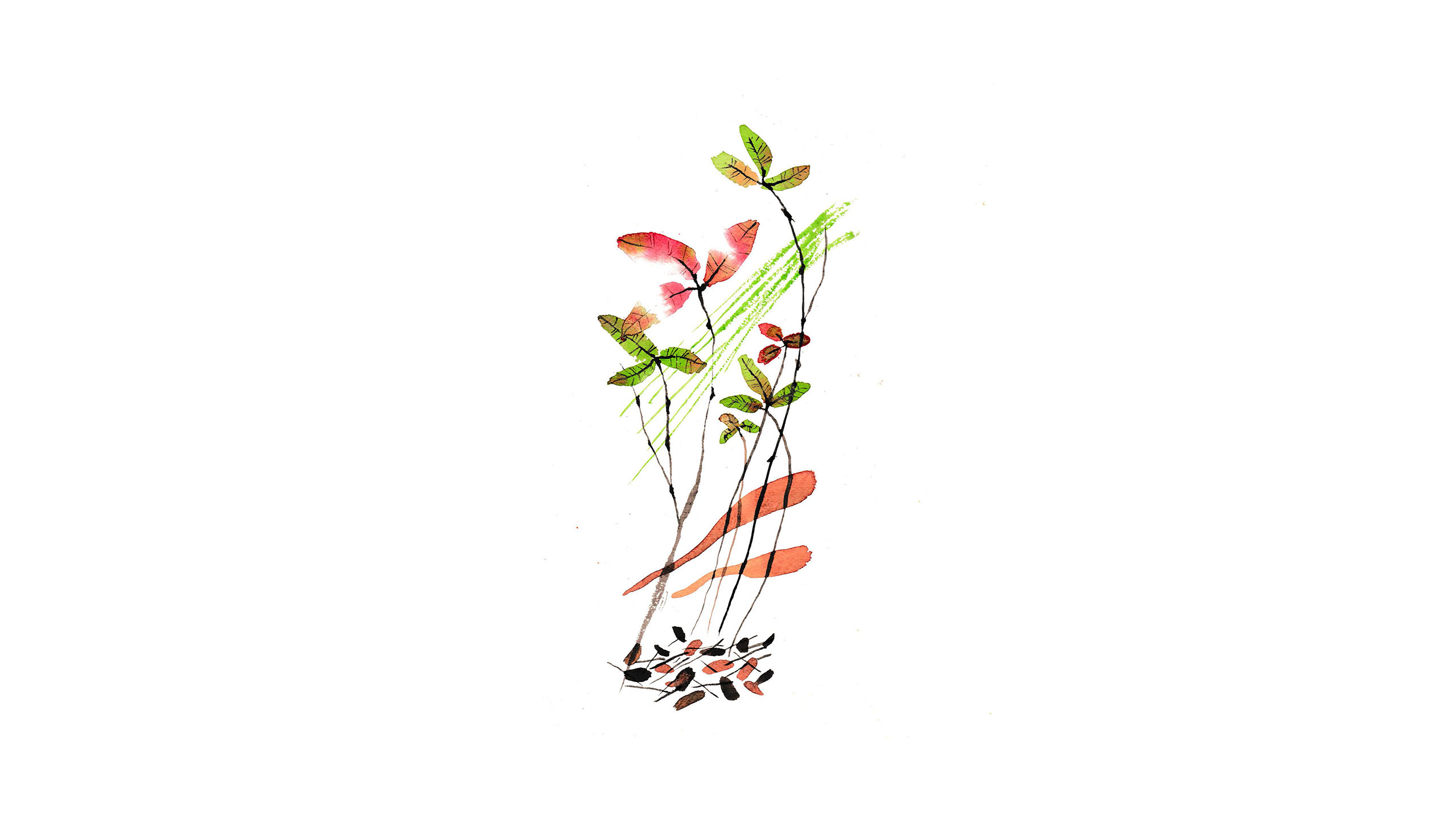 close
close
Watercolor Sketches of Southern California — art book
Read moreConstant Pierson
A personal meditative-like journey through three distinct Southern California landscapes, this book presents photography along with artistic interpretations. Artwork focuses on shapes, colors and patterns found in nature that reflect an emotional connection for the artist. The three regions include marine coastal, conifer forest and Joshua Tree National Park. Some artistic images are realistic representations, while others are poetic abstracts.
 close
close
The Adventure Under the Sea — children’s pop-up book
Read moreIvanna Zuo and Yanqi Li
Combining the charm and magic of 3D pop-ups with colorful illustrations, this children’s book is designed for readers age 8 and up who will enjoy the undersea adventure story as they learn about symbiosis. The protagonists, Cici and Bobo, meet the animals and plant life of a coral reef and discover how coral and algae keep their ecosystem in balance. The book strives to instill a sense of wonder and awareness that can lead to a desire to protect the ecosystems. The book includes a science fact page so readers can continue their exploration.
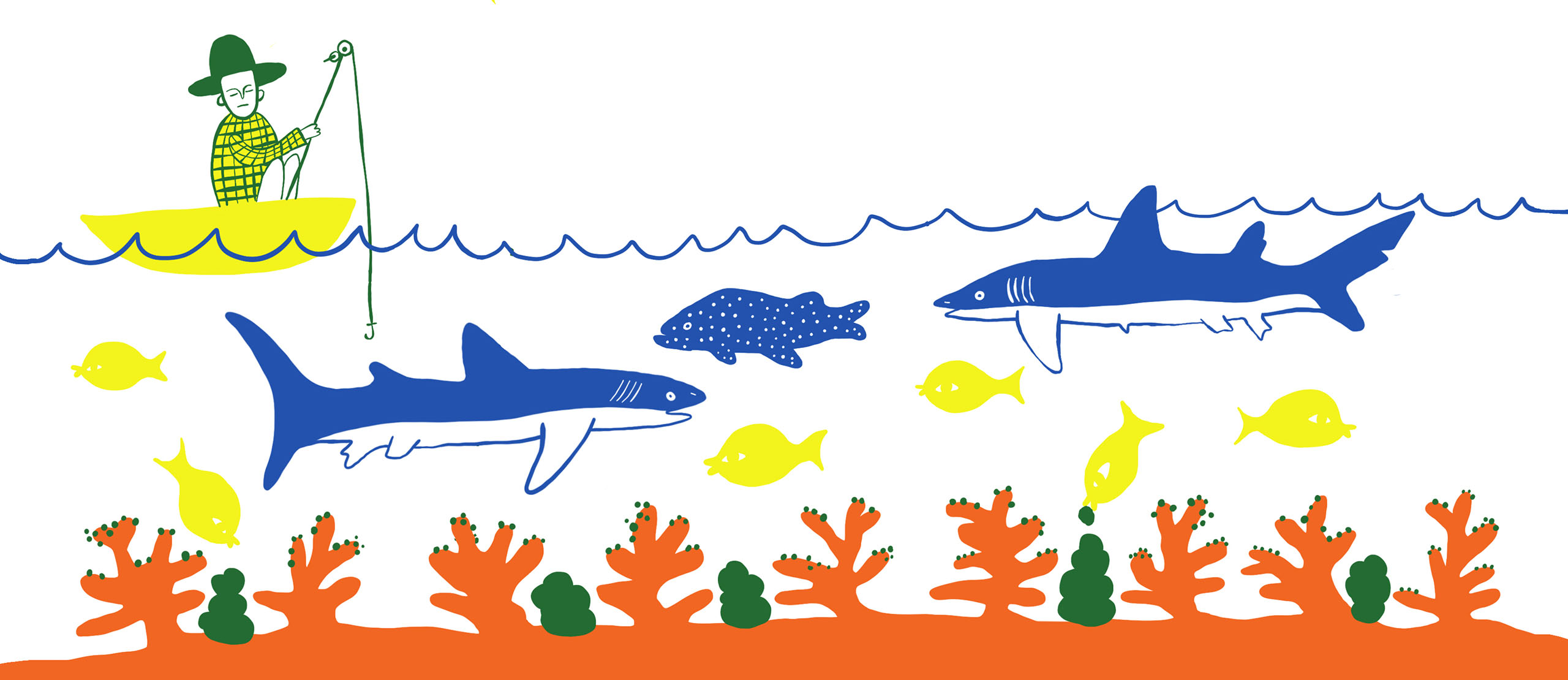 close
close
Coral Reefs — posters
Read moreLili Todd
Promoting empathy for the natural world, these posters communicate how a healthy coral reef ecosystem is based on symbiotic partnerships of organisms. One poster is designed in sketch-note style with multiple fun and informative graphics; the other is a simple statement with engaging illustrations. Both advocate for a healthy marine ecosystem and depict the negative impact humans have on the environment.
Posters can be distributed as a free resource for educators, parents who are homeschooling or older students.
 close
close
Symbiosis as a Community Structure — book
Read moreMadison E. Griffin
This book highlights the unique nature of symbiosis while encouraging readers to take action to promote a more responsible stewardship of the planet. The flip side of the book jacket doubles as a check-list style poster; readers can use this poster to help them reflect on their sustainability goals and learn how small changes can lead to big differences.
The book has two sections: one is a detailed description of various symbiotic partnerships. The second section outlines how humans have a parasitic relationship to earth, and offers way to minimize further degradation, such as using sustainable materials, being responsible for waste materials, and eating less meat.
 close
close
The Magical Mysteries of Mia’s Mouth — children’s book
Read moreRachael Chan
This colorful book seeks to excite young readers (ages 4-8) about science and the fascinating microbial diversity found within human bodies. The storyline follows an endearing main character, Mia, as she learns about the small things that live inside her mouth. Mia is magically transported into the world of the mouth, where she encounters immune-building bacteria and strange landscapes with microscopic creatures in an environment bustling with symbiotic relationships. When Mia hears her mother calling her to dinner, she waves goodbye to her new friends and returns to her world with a deeper appreciation of the complexities of symbiosis.
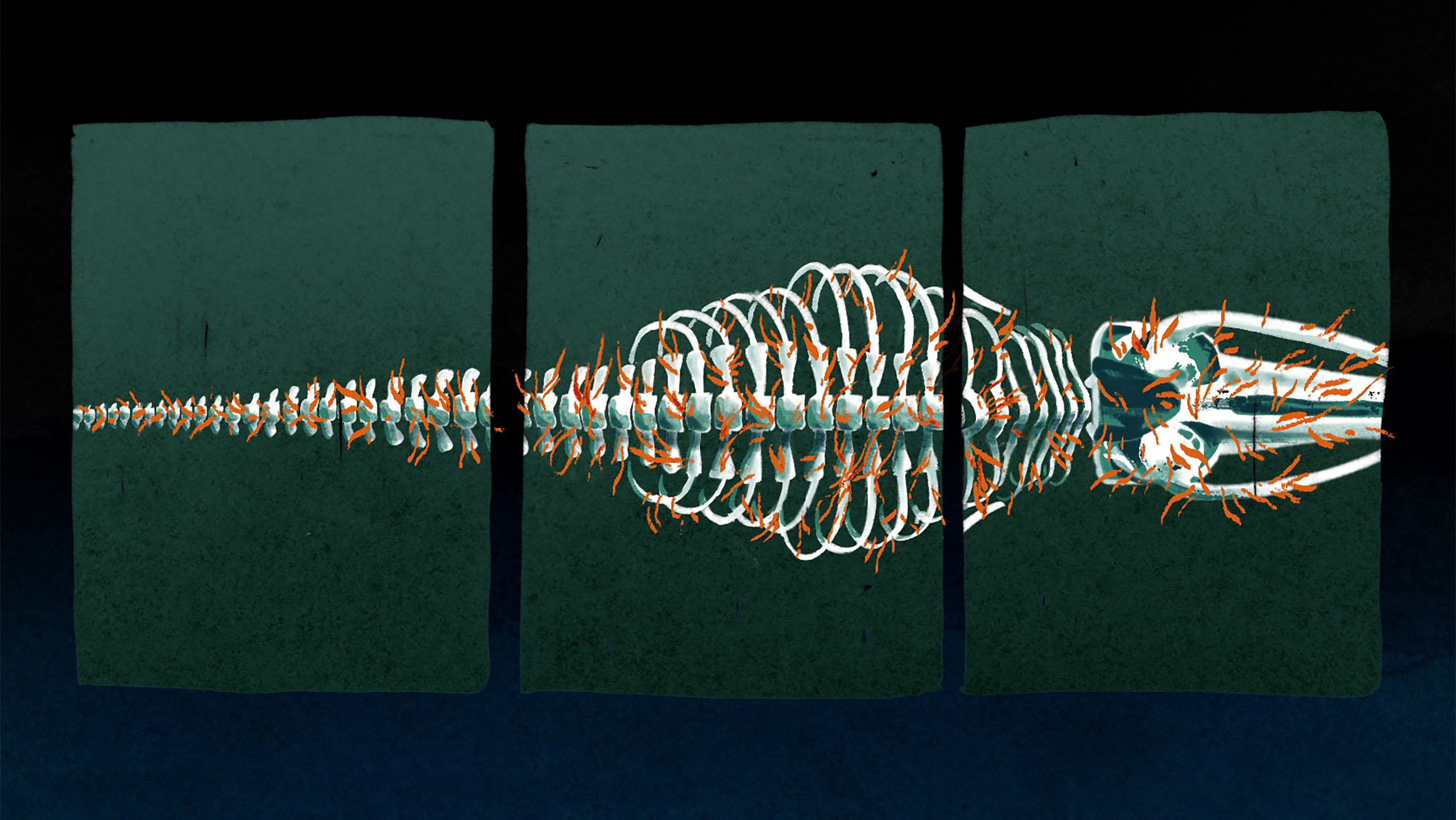 close
close
Under Currents — vertical comic
Read moreAmanda Oesef
In this continuous vertical comic, scientific concepts fuel abstract contemplation on human nature and the poetry of living things. Using whales as a thematic bridge, the comic explores the rich ecosystem of a whale carcass, as well as human relationships with whales throughout history.
The visual story starts with a scientist in Chile’s Atacama Desert driving to view the graveyard of poisoned whales. This action propels the story, which features evocative and powerful graphics. Bold images seamlessly flow into each other, including osedax worms feasting on whale carcasses, a process that sustains life even after death.
The storyline also features scenes contrasting aboriginal whaling practices with the commercial whaling that nearly decimated whale species in the late 1800s and early 1900s.
 close
close
Symbiotic Universe of the Kiwa Puravida — Zine
Read moreSophia H. Kiuchi
Textured graphics and vibrant colors tell the story of one yeti crab’s relationship with the world, presenting a powerful example of symbiosis. Each page is composed with a different artistic method, such as graphite, ink, watercolor, and digital. An interactive element invites readers to use a red magnifying glass to find a crab hidden among the kelp. Text relates the intricate connections the crab has with its environment and advocates protection of this species, as well as all ocean life.
 close
close
Cyanobacteria: Giver of Life — graphic/mural/digital
Read moreMelissa Fernandez, Misa Jia, Faith King
This panoramic visual represents the history of cyanobacteria, its symbiotic relationship with moss, and the important life-giving nutrients it provides. Artwork seamlessly transitions from concept to concept, from cellular representations to larger life forms. Bold, rich imagery gives the piece a deeply cohesive overview of nuances, details and important elements of cyanobacteria.
This long panel illustration can be altered for coloring books, murals, digital scrolls and other applications.
 close
close
Symbiosis Lab[S]tory — café/coffee shop design
Read moreHannah Shin
This architectural concept for a science-themed café offers guests opportunities to learn symbiotic concepts while leisurely enjoying beverages with friends. As a destination experience geared for 16-25 year olds, the café takes its cue from a science lab and guests can wander in and out of four “flasks.” Posters depict specialty drinks that reflect various scientific principles.
“This studio has been quite a light in my life for the last few months. It’s easy for scientists to stagnant and get caught in our same routine and you have given me a new perspective and stimulated my own creativity. These months have been challenging. Science has come to an almost all-time standstill, but you have made the broader impact of my research and science in general, really come to life.”
– Dr. Shana Goffredi, Associate Professor of Biology, Occidental College
Next Steps
In Spring 2021, Rachael Chan was selected to be the Designmatters Fellow at JCVI to continue to develop her work from the SINC studio and work on additional projects with the scientists and researchers.
A full publication on the SINC project, process and outcomes is slated to be published in Spring 2022.
-
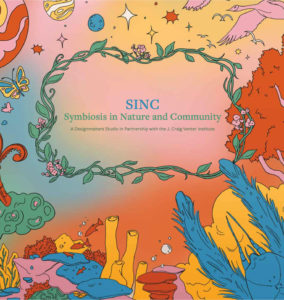
-
SINC: Symbiosis in Nature and Community – Process Book
The SINC Process book documents the fourteen week “SINC” transdisciplinary studio In partnership with the J. Craig Venter Institute.
This Designmatters studio challenged ArtCenter students to explore, conceptualize and translate scientific research on symbiosis into compelling visuals that communicate scientific discoveries to a broad range of audiences.
This material is based upon work supported by the National Science Foundation under Grant No. IOS 1926972.
